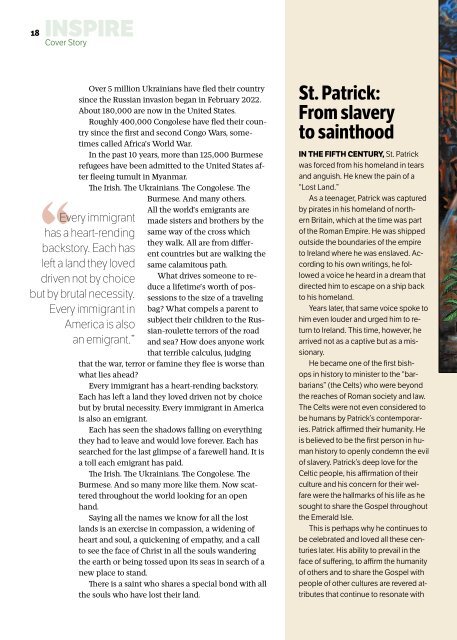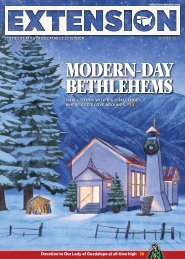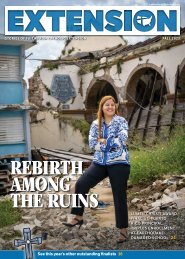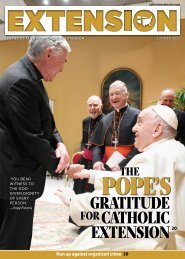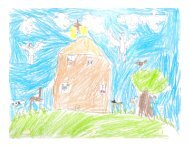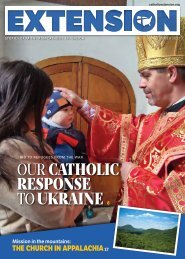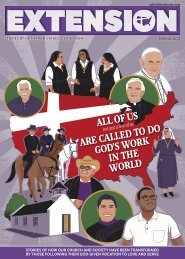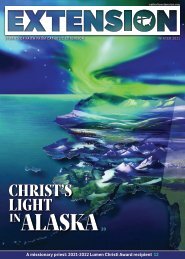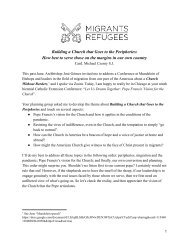Extension magazine - Spring 2023
A beautiful mosaic of St. Patrick is displayed on St. Patrick Cathedral in the Diocese of El Paso, Texas. He is the patron of this majority-Hispanic community, as well as many other Catholic Extension-supported diverse faith communities across the country.Today, his story of resilience and faith resonates with the descendants of those who fled hunger and poverty in Ireland, as well as refugees finding new homes in America.
A beautiful mosaic of St. Patrick is displayed on St. Patrick Cathedral in the Diocese of El Paso, Texas. He is the patron of this majority-Hispanic community, as well as many other Catholic Extension-supported diverse faith communities across the country.Today, his story of resilience and faith resonates with the descendants of those who fled hunger and poverty in Ireland, as well as refugees finding new homes in America.
You also want an ePaper? Increase the reach of your titles
YUMPU automatically turns print PDFs into web optimized ePapers that Google loves.
18 INSPIRE<br />
Cover Story<br />
<strong>Extension</strong> | <strong>Spring</strong> <strong>2023</strong> 19<br />
Over 5 million Ukrainians have fled their country<br />
since the Russian invasion began in February 2022.<br />
About 180,000 are now in the United States.<br />
Roughly 400,000 Congolese have fled their country<br />
since the first and second Congo Wars, sometimes<br />
called Africa’s World War.<br />
In the past 10 years, more than 125,000 Burmese<br />
refugees have been admitted to the United States after<br />
fleeing tumult in Myanmar.<br />
The Irish. The Ukrainians. The Congolese. The<br />
Burmese. And many others.<br />
All the world’s emigrants are<br />
made sisters and brothers by the<br />
“Every immigrant<br />
has a heart-rending<br />
backstory. Each has<br />
left a land they loved<br />
driven not by choice<br />
but by brutal necessity.<br />
Every immigrant in<br />
America is also<br />
an emigrant.”<br />
same way of the cross which<br />
they walk. All are from different<br />
countries but are walking the<br />
same calamitous path.<br />
What drives someone to reduce<br />
a lifetime’s worth of possessions<br />
to the size of a traveling<br />
bag? What compels a parent to<br />
subject their children to the Russian-roulette<br />
terrors of the road<br />
and sea? How does anyone work<br />
that terrible calculus, judging<br />
that the war, terror or famine they flee is worse than<br />
what lies ahead?<br />
Every immigrant has a heart-rending backstory.<br />
Each has left a land they loved driven not by choice<br />
but by brutal necessity. Every immigrant in America<br />
is also an emigrant.<br />
Each has seen the shadows falling on everything<br />
they had to leave and would love forever. Each has<br />
searched for the last glimpse of a farewell hand. It is<br />
a toll each emigrant has paid.<br />
The Irish. The Ukrainians. The Congolese. The<br />
Burmese. And so many more like them. Now scattered<br />
throughout the world looking for an open<br />
hand.<br />
Saying all the names we know for all the lost<br />
lands is an exercise in compassion, a widening of<br />
heart and soul, a quickening of empathy, and a call<br />
to see the face of Christ in all the souls wandering<br />
the earth or being tossed upon its seas in search of a<br />
new place to stand.<br />
There is a saint who shares a special bond with all<br />
the souls who have lost their land.<br />
St. Patrick:<br />
From slavery<br />
to sainthood<br />
IN THE FIFTH CENTURY, St. Patrick<br />
was forced from his homeland in tears<br />
and anguish. He knew the pain of a<br />
“Lost Land.”<br />
As a teenager, Patrick was captured<br />
by pirates in his homeland of northern<br />
Britain, which at the time was part<br />
of the Roman Empire. He was shipped<br />
outside the boundaries of the empire<br />
to Ireland where he was enslaved. According<br />
to his own writings, he followed<br />
a voice he heard in a dream that<br />
directed him to escape on a ship back<br />
to his homeland.<br />
Years later, that same voice spoke to<br />
him even louder and urged him to return<br />
to Ireland. This time, however, he<br />
arrived not as a captive but as a missionary.<br />
He became one of the first bishops<br />
in history to minister to the “barbarians”<br />
(the Celts) who were beyond<br />
the reaches of Roman society and law.<br />
The Celts were not even considered to<br />
be humans by Patrick’s contemporaries.<br />
Patrick affirmed their humanity. He<br />
is believed to be the first person in human<br />
history to openly condemn the evil<br />
of slavery. Patrick’s deep love for the<br />
Celtic people, his affirmation of their<br />
culture and his concern for their welfare<br />
were the hallmarks of his life as he<br />
sought to share the Gospel throughout<br />
the Emerald Isle.<br />
This is perhaps why he continues to<br />
be celebrated and loved all these centuries<br />
later. His ability to prevail in the<br />
face of suffering, to affirm the humanity<br />
of others and to share the Gospel with<br />
people of other cultures are revered attributes<br />
that continue to resonate with<br />
people across the globe.<br />
In the United States, the saint’s legacy<br />
lives on in the hearts of our 31.5<br />
million Irish Americans. Just as St. Patrick<br />
extended himself beyond his own<br />
country and culture, so too does his<br />
following extend beyond the descendants<br />
of Ireland, especially among<br />
those who have had to tearfully leave<br />
their homeland as he once did.<br />
As evidence of his enduring popularity,<br />
Catholic <strong>Extension</strong> has records<br />
dating back to 1905 that indicate<br />
that we have helped build or<br />
repair hundreds of churches named after<br />
the beloved saint. These churches<br />
are located across the country, from<br />
Montana to Puerto Rico—each one a<br />
unique chapter in the story of St. Patrick’s<br />
legacy in America.<br />
ILLUSTRATION SAMUEL LIND<br />
An illustration<br />
of St. Patrick<br />
created for Holy<br />
Spirit and St.<br />
Patrick Church, a<br />
Black Caribbean<br />
parish in Loíza,<br />
Puerto Rico.<br />
BELOW A parishioner at Holy Spirit and<br />
St. Patrick Church in Loíza, Puerto Rico,<br />
celebrates her faith and culture with “La<br />
Bomba” dance.<br />
THE FOLLOWING FOUR COM-<br />
MUNITIES each possess their own<br />
special connection to St. Patrick.<br />
Each shows how the spirit of St.<br />
Patrick remains alive and well today<br />
throughout our country.<br />
St. Patrick in<br />
Puerto Rico<br />
LOÍZA, PUERTO RICO, is home to<br />
one of the oldest Catholic parishes<br />
under the American flag. Founded<br />
in 1645, St. Patrick is its patron.<br />
The town has a predominantly<br />
Black Caribbean population that<br />
descended from enslaved people<br />
brought from Africa. It is believed<br />
that the slave ships stopped in<br />
Loíza to dispose of the slaves who<br />
were on the brink of death after<br />
the grueling journey across the<br />
Atlantic Ocean. Those who survived<br />
eventually settled in Loíza. How did<br />
this Black Caribbean community<br />
descended from former slaves come<br />
to adopt the Irish saint as its patron?<br />
The community had experienced<br />
multiple devastating yuca famines<br />
and was searching for a powerful<br />
intercessor. Yuca is a root vegetable<br />
and major food staple in the Caribbean,<br />
much like the potato was in<br />
Ireland. The people<br />
turned to St. Patrick<br />
for help. When<br />
the yuca famine<br />
ended, which they<br />
attributed to the<br />
power of St. Patrick,<br />
they re-dedicated<br />
their church and<br />
added St. Patrick’s<br />
name, becoming<br />
Holy Spirit and<br />
St. Patrick Church.


